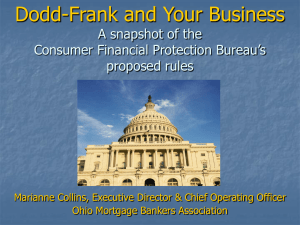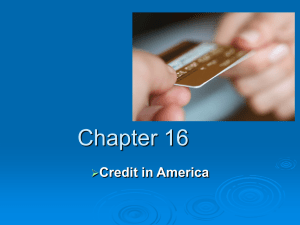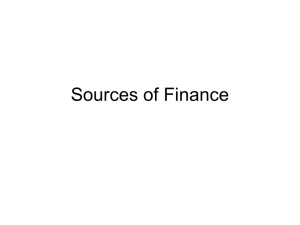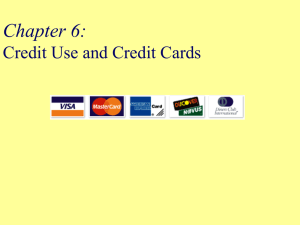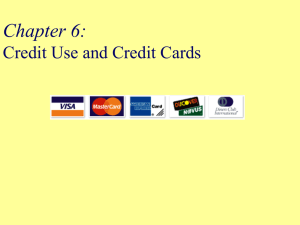California Mortgage Loan Brokering & Lending
advertisement
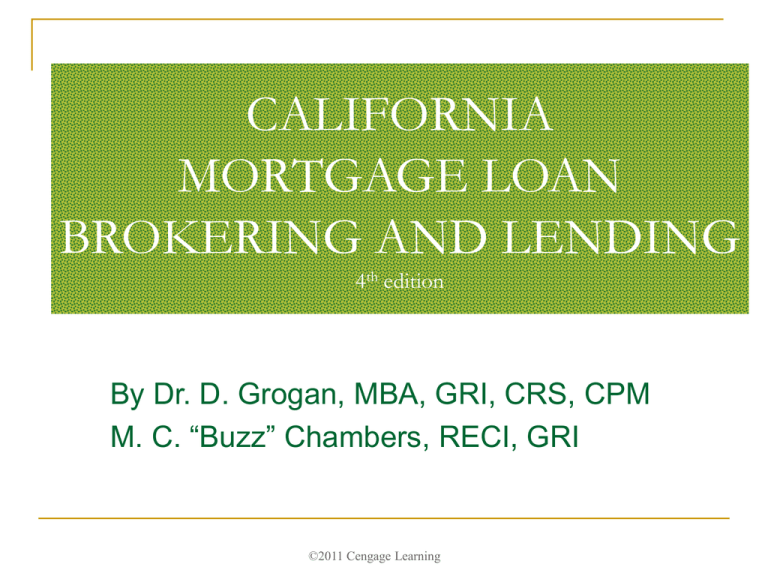
CALIFORNIA MORTGAGE LOAN BROKERING AND LENDING 4th edition By Dr. D. Grogan, MBA, GRI, CRS, CPM M. C. “Buzz” Chambers, RECI, GRI ©2011 Cengage Learning Contents PART 1 SCOPE OF THE BUSINESS Ch 1: Scope of the Loan Brokerage 1.1 Overview of the Book 1.2 Historic perspective Hard money versus seller carry-back money Careers in mortgage loan brokering Loan originators 1.4 Licenses and Professional organizations Legal and licensing requirements Professional organizations Ch 2: Sources of Business 2.1 Getting started 2.2 Marketing 2.3 Advertising 2.4 Other Sources of Business 1.3 Basic information In the beginning Early progress Unstable market Today Referrals from Realtors Referrals from Other sources Referrals from the Public Testimonial 2.5 Types of Media ©2011 Cengage Learning Affiliation Billboards, benches, Buses Direct advertising Direct main advertising Internet Magazines News Releases Newspapers Contents 2.5 Types of Media (continued) Office supplies Promotional materials Radio Realtors® Telemarketing Television Trade Shows Networking group 2.6 Advertising regulations PART 2 Loans Ch 3: Loans Conventional 3.1 How a mortgage broker selects a loan 3.2 Conventional loan features Licensee advertising License number on business cards Advance Fee Advertising Regulation Z Advertising Disclosures Fair Housing Terminology Loan amounts Eligibility requirements for high-balance loans Loan to value ratio Loan to value payment Fixed rate loan Bi-Weekly fixed rate loans The 10- or 15-year mortgage Adjustable rate mortgages Index Treasury bill rate LIBOR The two step mortgage Price level-adjusted mortgage Reverse annuity mortgage ©2011 Cengage Learning Contents 3.2 Conventional loan features (cont.) FNMA & FHLMC loan programs Condominium loans 3.3 Mortgage insurance 3.4 California loan programs 3.5 Refinance, Equity and Junior or Sub-Prime loans Refinance loan Junior liens Home equity line of credit Loans: Sub-Prime borrowers Defaults California housing finance agency Southern California Home Financing Authority Hope for Ownership of Single Family Homes Home Investment and Affordable Housing Public Employees Retirement System State Teacher Retirement System Home Ownership Program My Community mortgage loan Energy Efficient Mortgage Other loan programs Ch 4: Loans: Government 4.1 FHA loans ©2011 Cengage Learning Statutory loan amount limits FHA 202 FHA 203B and FHA 203I FHA 302 K FHA 207 Contents 4.1 FHA loans (cont.) FHA 221 d 2 FHA 221 d 3 FHA 221 d 4 FHA 223 e FHA 223 f FHA 234 FHA 237 FHA 238 FHA 244 FHA 245 FHA 251 (ARM) FHA 255 (HECM) FHA Title I FHA Energy Efficient Mortgage (EEM) 4.2 FHA loan considerations FHA versus first-time-home buyers (FTHB) FHA MIP FHA Streamline loan (rate reduction) Other FHA features and loan programs Secondary residence FHA housing loan programs 4.3 Veterans loans Veterans regulated closing costs DVA loans with second trust deeds DVA refinances Rate reduction refinance Standard refinance DVA jumbo loan Veteran’s EEM (DVA EEM) Sellers’ concessions FHA or DVA loan approval ©2011 Cengage Learning Contents 4.4 Credit Alert Interactive Voice Response System (CAIVRS) 4.5 California Veteran (Cal Vet) 4.6 SBA Ch 5: Loans Financial Disclosure and Other Real Estate Disclosures Real Estate Settlement Procedures Act (RESPA) Regulation X (Reg X) Home Mortgage Disclosure Act (HMDA) Home Mortgage Disclosure (Reg C) 5.1 Federal TIL (Reg Z) 5.2 APR 5.3 Section 32 loan guidelines 5.4 Federal RESPA, Reg X 5.5 HMDA (Reg C) 5.6 Government loan disclosures 5.7 California disclosures Required disclosures for FHA loans Required disclosures for DVA loans Mortgage loan disclosure statement 5.8 California licensee non-loan disclosures ©2011 Cengage Learning Appraisal disclosures Credit and fair lending disclosure Death of acquired immunodeficiency syndrome (AIDS) Earthquake disclosure Energy conservation, retrofit and thermal disclosure Environmental hazards disclosures Fire hazard areas (state responsibility areas) Flood disaster areas Foreign investment in real estate tax act (FIRPTA) and Cal-FIRPTA Contents 5.8 California licensee non-loan disclosures (cont.) Flood disaster areas Foreign investment in real estate tax act (FIRPTA) and Cal-FIRPTA Government compliance disclosure Hazard insurance coverage Language of the agreement Lead-based paint Local option disclosure statement Supplemental property taxes disclosure Mello Roos disclosure Methamphetamine-contaminated properties Pest control REO property (REO) Smoke detector compliance Title insurance advisory Transfer disclosure statement (TDS) 5.8 California licensee non-loan disclosures (cont.) 5.9 Other loan disclosures Article 7 Prepayment penalty Liability Loan terms Maximum charges 5.10 Predatory lending law Utility line extensions Water heater bracing Lender/purchaser disclosure statement Disclosure Prohibited loan terms Prohibited practices Penalties and corrective action Balloon payment 5.11 Good Faith Estimate (GFE) ©2011 Cengage Learning Contents PART 3: Processing Ch 6 Processing: Pre-qualification and loan application 6.1 Lender/purchase statement 6.2 Disclosure of home ownership counseling 6.3 Residential loan application 6.4 Qualifying ratios 6.5 Department of Veterans Administration (DVA) qualifications 6.6 Federal Housing Administration (FHA) qualifications 6.7 Conventional qualifications 6.8 Other qualifications Ch 7 Processing: Credit and disclosures 7.1 Credit 7.2 Credit and FICO score 7.3 Privacy policy 7.4 ECOA 7.5 Non-traditional credit reports 7.6 The housing financial discrimination act of 1977 (Fair lending notice) Ch 8 Processing: Verifications and stacking order ©2011 Cengage Learning 8.1 Processing tools 8.2 The processor’s file 8.3 Income and guidelines for the processor 8.4 Borrow documentation 8.5 Sample loan file 8.6 Stacking order Contents Ch 9 Processing: Escrow, settlement, title and appraisal 9.1 Escrow 9.2 Statement of Information 9.3 Impound account 9.4 Title insurance 9.5 Appraisal Ch 11 Processing: Docs, funding and closing Ch 10 Processing: Underwriting and quality control 10.1 Underwriting 10.2 Red Flags 10.3 Quality control and auditing 11.1 Conditions prior to Docs 11.2 Drawing Docs 11.3 Conditions prior to funding 11.4 Loan documents 11.5 Funding 11.6 Closing PART 4 The Secondary Money Market Ch 12 Shipping and Servicing ©2011 Cengage Learning 12.1 Shipping 12.2 Loan servicing 12.3 Securities dealer 12.4 Types of securities 12.5 Real estate economics 12.6 The secondary money market: Investor protection Contents Ch 12 Shipping and Servicing (cont.) 12.7 Packaging and selling loans 12.8 Yield spread premium 12.9 National Code of Real Estate Loan Servicing Industry PART 5 Regulations and Operations Ch 13 The business operational practices and Department of Corporations (DOC) licensing 13.1 Employment considerations 13.2 Business office operations 13.4 Wholesale broker agreement 13.4 How to become a mortgage banker 13.5 Computer applications and publications 13.6 Acts by the loan agent 13.7 Compensation and referral fees 13.8 Exemptions from the licensing requirements 13.9 License law for the loan agents 13.10 California DOC Ch 14 The California Department of Real Estate (DRE) license activity for loan agents ©2011 Cengage Learning 14.1 California Department of Real Estate (DRE) license 14.2 DRE Broker supervision 14.3 California codes and regulations for licensees 14.4 Review of instruments 14.5 California financial code 14.6 Trust Funds Contents Ch 15 Math and trust funds for the loan agent 15.1 Introduction 15.2 LTV ratio 15.3 Borrowing qualifying income 15.4 Payment factor chart 15.5 Amortization comparisons 15.6 Financial calculators 15.7 Trust fund accounting Appendix Appendix A: Loan application FNMA Form 1003: English and Spanish Appendix B: Credit Report Appendix C: Verifications Appendix D: Sale Escrow Instructions Appendix E: Appraisal Report Appendix F: Preliminary Title Report Appendix G: Loan documents Appendix H: Employment forms Appendix I: Wholesale Brokerage Agreements Appendix J: Internet Web Sites Appendix K: Glossary of terms ©2011 Cengage Learning




